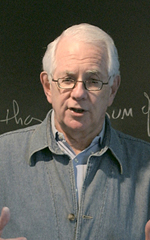Previous speakers and artists
| |
 |
|
February 6-10, 2017
How basic science drives technological progress
Prof. Sheldon L. Glashow
|
|
|
Keynote Speaker
Professor Sheldon Lee Glashow shared the 1979 Nobel Prize for Physics with Prof. Steven Weinberg and Prof. Abdus Salam for unifying the theories of weak and electromagnetic forces. The new "electroweak" theory, which explains the unity of electromagnetism and the weak force, underlies all of particle physics and provides a framework for understanding how the early universe evolved and how the chemical elements were created.
In 1964, while working with Prof. James Bjorken, Professor Glashow was the first to predict the existence of a fourth quark, which he originally named the "charmed quark". Through this he demonstrated that the quark pairs would largely cancel out flavor changing neutral currents as well as eliminating a technical disaster for any quantum field theory with unequal numbers of quarks and leptons - an irregularity. Along with Prof. Howard Georgi in 1973 Professor Glashow devised the first grand unified theory, and this work has become the groundwork for all future unifying work.
Professor Glashow's research has been instrumental in our understanding of how our universe came into being. In the years since winning the Nobel Prize he has helped to further develop the Grand Unified Theory of all particles and all forces. Its predictions led to the construction of massive underground detectors, the refinement of the unification models, the first observation of neutrinos from a supernova and the recent discovery that neutrinos have mass. This has fueled an ongoing search for rare events and exotic effects that may shed further light on the evolution of the early universe.
Professor Glashow has done seminal research in the fields of elementary particle physics and cosmology, and his work led to the prediction of neutral currents, charmed particles and intermediate vector bosons, all of which were subsequently discovered by experiments. He played a key role in unifying the weak and electromagnetic forces and in creating today's successful "standard model of particle physics". He is the author of some 300 research papers and of books such as Interactions (with Ben Bova, 1988), The Charm of Physics (1990) and From Alchemy to Quarks (1993).
Born in Manhattan, Sheldon Glashow knew from an early age that he would become a scientist. When he was 10 years old, he became interested in the laws of falling bodies, and at the age of 15 he helped his father equip a basement chemistry lab. Educated at Cornell University (A.B. 1954) and having completed his graduate studies at Harvard University (M.A. 1955, PhD 1959 under Nobel Laureate physicist Prof. Julian Schwinger), Sheldon Glashow won a National Science Foundation (NSF) postdoctoral fellowship and planned to work at the Lebedev Institute in Moscow with the physicist Prof. Igor Tamm, who enthusiastically supported his proposal. However, he spent the tenure of his fellowship at the Niels Bohr Institute in Copenhagen, with some time at the European Organization for Nuclear Research (CERN), waiting for a Russian visa that never came. Perhaps all was for the best, because in these years he discovered the SU(2) x U(1) structure of the electroweak theory.
Sheldon Glashow became an assistant professor at Stanford University and then spent several years on the faculty of the University of California at Berkeley. In 1966 he returned to Harvard University as the Eugene Higgins Professor of Physics. He remained at Harvard, except for stays at CERN, the Massachusetts Institute of Technology (MIT) and the University of Marseilles.
In 2000 Professor Glashow became the Arthur Metcalf Professor of Mathematics and the Sciences at Boston University while remaining the Higgins Professor of Physics (Emeritus) at Harvard University. He has served the Science Policy Committee of CERN from 1979 until 1985, and in 2005 he became a Member of the Advisory Board of the International Peace Foundation. He was awarded the European Physical Society Prize for Particle Physics in 2011.
SCHEDULE
Monday, February 6, 2017:
10:00 Dialogue with high school students at St. Andrews International School Sathorn in Bangkok
(not a public event)
14:00 Dialogue with high school students at St. Andrews International School Sukhumvit in Bangkok
(not a public event)
Wednesday, February 8, 2017:
10:00 Dialogue with high school students at Binus School Simprug in Jakarta
(not a public event)
14:00 Keynote speech and dialogue at Binus University in Jakarta
Information and free seat
reservation: phone (021) 534-5830 ext. 1320, mobile (811) 166-8574, email kimam@binus.edu
Friday, February 10, 2017:
14:00 Keynote speech and dialogue at Gadjah Mada University in Yogyakarta
Information and free seat
reservation: phone (0274) 649-1927, fax (0274) 552-810, email head-oia@ugm.ac.id |
|